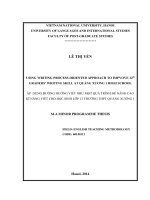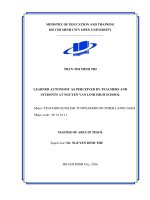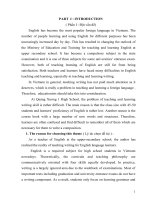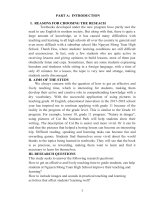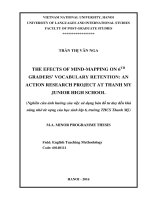the effects of mind mapping on the 12th graders’ vocabulary learning at nguyen van khai high school
Bạn đang xem bản rút gọn của tài liệu. Xem và tải ngay bản đầy đủ của tài liệu tại đây (1.4 MB, 98 trang )
MINISTRY OF EDUCATION AND TRAINING
HO CHI MINH CITY OPEN UNIVERSITY
THE EFFECTS OF MIND MAPPING ON THE 12TH GRADERS’
VOCABULARY LEARNING AT NGUYEN VAN KHAI HIGH SCHOOL
A thesis submitted in partial fulfillment of the requirements
for the degree of Master of Arts in TESOL
Submitted by DO NGUYEN XUAN THAO
Supervisor: NGUYEN THANH TUNG, Assoc. Prof. Dr.
HO CHI MINH City
November 2015
MINISTRY OF EDUCATION AND TRAINING
HO CHI MINH CITY OPEN UNIVERSITY
------------------------------------------
DO NGUYEN XUAN THAO
THE EFFECTS OF MIND MAPPING ON THE 12TH GRADERS’
VOCABULARY LEARNING AT NGUYEN VAN KHAI HIGH SCHOOL
Major: TEACHING ENGLISH TO SPEAKERS OF OTHER LANGUAGES
Major code: 60140111
MASTER OF ARTS IN TESOL
Supervisor: NGUYEN THANH TUNG, Assoc. Prof. Dr.
HO CHI MINH City, 2015
STATEMENT OF AUTHORSHIP
I certify that the thesis entitled “The effects of mind mapping on the 12th graders‟
vocabulary learning at Nguyen Van Khai High School” is my original work. It is based
on my own research to meet the requirements for theses in Master‟s Programs at Ho Chi
Minh City Open University issued by the Higher Degree Committee
All sources used by me have been documented. No other person‟s work has been used
without due acknowledgement.
This thesis has not previously been submitted for assessment in this or any other subject
or course at this University or elsewhere.
Dong Thap, August 2015
DO NGUYEN XUAN THAO
i
RETENTION AND USE OF THE THESIS
I hereby state that I, Do Nguyen Xuan Thao, being the candidate for the degree of Master
of to the TESOL, accept the requirement of University relating to the retention and use of
the Master‟s theses deposited in the University library.
In terms of these conditions, I agree that the original of my thesis deposited in the
University library should be accessible for the purposes of the studies and research, in
accordance with the normal condition established by the library for care, loan, and
reproduction of thesis.
ii
ABSTRACT
The teaching and learning of vocabulary at a high school has recently been paid much
more attention to by teachers and learners. However, many students still have some
trouble in lexical learning due to the lack of a suitable learning strategy. Thus, this study
was carried out to examine the role of „mind mapping‟ in improving vocabulary of the
12th graders at Nguyen Van Khai High School in Dong Thap Province.
Based on the theoretical framework of mind-mapping, the quasi-experimental research
was carried out during the first semester. Fifty-six students of the two classes at Nguyen
Van Khai High School were divided into two groups: control group and experimental
group. Data were collected from three sources: (1) the final Grade 11 exam of the second
semester of the previous academic year and post-test to estimate the students‟ vocabulary
improvement after the treatment, (2) the pre- and post- questionnaire to assess what the
changes in their attitude towards vocabulary learning with mind-mapping were, and (3)
interview with ten students in the experimental group to clarify their attitude.
The findings of the study reveal that mind-mapping affects the Nguyen Van Khai High
School students‟ lexical ability a lot. In fact, it not only helps them remember words
longer but also do tests better. Moreover, questionnaires and interviews show that they
feel more relaxed, active, creative, and learner-centered. Thanks to this, their motivation
to learn vocabulary increased.
iv
TABLE OF CONTENTS
STATEMENT OF AUTHORSHIP ...................................................................................... i
RETENTION AND USE OF THE THESIS ....................................................................... ii
ACKNOWLEDGEMENTS ............................................................................................... iii
ABSTRACT ....................................................................................................................... iv
TABLE OF CONTENTS .................................................................................................... v
LIST OF FIGURES .......................................................................................................... viii
LIST OF TABLES ............................................................................................................. ix
LIST OF ABBREVIATIONS ............................................................................................. x
CHAPTER 1: INTRODUCTION........................................................................................ 1
1.1 Background of the study ........................................................................................... 1
1.2 Statement of the problem.......................................................................................... 4
1.3 Purpose of the study and research questions ............................................................ 4
1.4 Significance of the study ............................................................................................ 4
1.5 Structure of the study................................................................................................ 5
CHAPTER 2: LITERATURE REVIEW ............................................................................ 6
2.1 The concept of mind mapping .................................................................................. 6
2.1.1 Definition of mind mapping ............................................................................... 6
2.1.2 Classification of mind mapping .......................................................................... 8
2.1.3 Characteristics of mind mapping ...................................................................... 16
2.2 Ways to make mind mapping ................................................................................. 18
2.3 Advantages and disadvantages of mind mapping .................................................. 22
2.3.1 Advantages ........................................................................................................ 22
2.3.2 Disadvantages ................................................................................................... 26
2.4 When and where to use mind mapping .................................................................. 26
2.5 Empirical research .................................................................................................. 28
2.6 Chapter summary.................................................................................................... 32
v
CHAPTER 3: METHODOLOGY ..................................................................................... 33
3.1 Overall approach ...................................................................................................... 33
3.2 Research site ........................................................................................................... 33
3.3 Research participants ............................................................................................. 34
3.4 Research instruments .............................................................................................. 36
3.4.1 Teaching material: Textbook ............................................................................ 36
3.4.2 The measurement instruments .......................................................................... 39
3.5 Procedure ................................................................................................................ 43
3.6 Analytical framework ............................................................................................. 44
3.6.1 Quantitative analysis of the Grade 11 final exam and post-test ....................... 44
3.6.2 Quantitative analysis of pre- and post-questionnaire ........................................ 45
3.6.3 Qualitative analysis of interview ...................................................................... 46
3.7 Validity and reliability............................................................................................ 46
3.8 Summary................................................................................................................. 48
CHAPTER 4: DATA ANALYSIS AND DISCUSSIONS ............................................... 49
4.1 Data analysis ............................................................................................................ 49
4.1.1 Results in the tests.............................................................................................. 49
4.1.2 Results from questionnaires ............................................................................... 54
4.1.3 Results from interview ....................................................................................... 65
4.1.4 Overall summary ............................................................................................... 69
4.2 Discussion of findings .............................................................................................. 69
4.2.1 General findings ................................................................................................. 69
4.2.2 Specific findings ................................................................................................ 70
4.2.3 Summary ............................................................................................................ 74
4.3 Chapter summary ..................................................................................................... 75
CHAPTER 5: CONCLUSIONS AND RECOMMENDATIONS .................................... 76
5.1 Conclusions .............................................................................................................. 76
5.2 Strengths and limitations in the methodology of the study...................................... 76
5.3 Recommendations .................................................................................................... 77
vi
5.3.1 The teachers ....................................................................................................... 78
5.3.2 The students ....................................................................................................... 78
5.4 Suggestions for further research............................................................................... 80
5.5 Summary .................................................................................................................. 80
REFERENCES .................................................................................................................. 81
APPENDIX 1 .................................................................................................................... 88
WORKSHEET 1 ............................................................................................................... 92
APPENDIX 2 .................................................................................................................... 93
APPENDIX 3 .................................................................................................................... 98
APPENDIX 4 .................................................................................................................. 100
APPENDIX 5 .................................................................................................................. 103
APPENDIX 6 .................................................................................................................. 106
APPENDIX 7 .................................................................................................................. 108
APPENDIX 8 .................................................................................................................. 111
APPENDIX 9 .................................................................................................................. 113
APPENDIX 10 ................................................................................................................ 114
vii
LIST OF FIGURES
Figure 2.1:
A mind map of wedding ............................................................................ 8
Figure 2.2:
Linear, circular, hub spokes, tree, and network ........................................ 8
Figure 2.3:
KWL chart ................................................................................................ 9
Figure 2.4.a: Venn diagram ............................................................................................. 9
Figure 2.4.b: Venn diagram of Whales and Fish ............................................................ 9
Figure 2.5:
QAR ........................................................................................................ 10
Figure 2.6:
Web organizer ......................................................................................... 11
Figure 2.7:
T chart ..................................................................................................... 11
Figure 2.8:
A network tree ........................................................................................ 12
Figure 2.9:
An event chain ....................................................................................... 12
Figure 2.10:
A cycle concept map .............................................................................. 12
Figure 2.11:
A spider concept map ............................................................................ 13
Figure 2.12:
Word relationships ................................................................................. 13
Figure 2.13:
Synonyms, antonyms, examples and non-examples.............................. 14
Figure 2.14:
Word connections .................................................................................. 14
Figure 2.15:
A word map ........................................................................................... 15
Figure 2.16:
A concept map ....................................................................................... 15
Figure 2.17:
A story map ............................................................................................ 16
Figure 2.18:
Mapping components ............................................................................. 16
Figure 2.19:
The structure of semantic maps ............................................................. 17
Figure 2.20:
How to make a mind mapping ............................................................... 20
Figure 4.1:
Pre-test score distribution of control and experimental group ................ 49
Figure 4.2:
Post-test score distribution of control and experimental group ............... 50
viii
LIST OF TABLES
Table 3.1: Participants‟ characteristics ...............................................................................35
Table 3.2: Teaching material ....................................................................................... 37
Table 3.3: Five degrees of grades to classify the students‟ ability .............................. 40
Table 3.4: Summary of instruments of data collection ................................................ 42
Table 3.5: Schedule for the main stages of data collection ......................................... 43
Table 3.6: Reliability statistics for pre-questionnaire .................................................. 48
Table 3.7: Reliability statistics for post-questionnaire ................................................ 48
Table 4.1: Group statistics of pre-test results .............................................................. 51
Table 4.2: Independent samples t-test of the two groups before the treatment ........... 52
Table 4.3: Group statistics of post-test results ............................................................. 53
Table 4.4: Independent samples t-test of the two groups after the treatment .............. 53
Table 4.5: The students‟ attitudes to vocabulary learning ........................................... 55
Table 4.6: The students‟ methods of self-studying vocabulary ................................... 56
Table 4.7: The teachers‟ methods of teaching vocabulary .......................................... 57
Table 4.8: The students‟ difficulties in learning vocabulary ....................................... 59
Table 4.9: The advantages to students who learn vocabulary by using mind mapping ..
........................................................................................................................................ 61
Table 4.10a: The disadvantages to students who learn vocabulary by using mind
mapping (before conversion) .......................................................................................... 62
Table 4.10b: The disadvantages to students who learn vocabulary by using mind
mapping (after conversion) ............................................................................................. 63
Table 4.11: The students‟ future eagerness in using mind-mapping to learn vocabulary
........................................................................................................................................ 64
Table 4.12: Students comments ................................................................................... 67
ix
LIST OF ABBREVIATIONS
A:
Agree
ANCOVA: Analyses of Covariance
ANOVA:
Analysis of Variance
D:
Disagree
EFL:
English as a Foreign Language
F:
Female
GCSE:
General Certificate for Secondary Education
MOET:
Ministry of Education and Training
M:
Mean or Male
MANOVA: Multivariate Analysis of Variance
MM(s):
Mind mapping(s)
N:
Number
SA:
Strongly agree
SD:
Strongly disagree
S.D.:
Standard Deviation
SPSS:
Statistical Package for the Social Sciences
Sts:
Students
x
CHAPTER 1: INTRODUCTION
1.1 Background of the study
Nowadays, English is one of the most popular languages in the world.
English also plays an increasingly important role in Vietnamese people‟s lives
because the development of globalization has impacted – and is still impacting –
this country Many foreign companies now invest in the Vietnamese market. There
are now good opportunities for English learners and users to find better jobs.
Therefore, it is becoming necessary for people to study English.
To master English well, one has to learn four skills, namely reading,
speaking, listening, and writing. Moreover, one has to grasp language areas such as
pronunciation, vocabulary and grammar. Among them, vocabulary plays an
influential part in learning English. Wilkins (1987, p. 135) declares that one can
express a few things even when one has no grammar; however, one could not
express anything without words. To prove the importance of vocabulary, Krashen
(1987, as cited in Lewis, 1993, p. iii) similarly asserts that when students travel
now, they will carry dictionaries instead of grammar books. Vocabulary is
extremely important to the process of learning English. It is an essential part of the
four skills: listening, speaking, reading, and writing. In these skills, if learners lack
lexical knowledge, they cannot demonstrate how well they have acquired the
language. With it, they feel more confident in attending a listening comprehension
test or an oral contest. They also communicate with others better. The more
vocabulary they acquire, the better they become.
Learning vocabulary has become a very important part of learning English.
Nevertheless, Vietnamese students are not very good at learning English
vocabulary and in rural areas – where information technology is not advanced
enough to meet the requirements of learning a foreign language – students still
encounter some obstacles.
1
Firstly, some students do not have a sustainable interest in learning
vocabulary (Dilek & Yürük, 2012). English is a compulsory subject at almost all
high schools and it plays an important role in the General Certificate for Secondary
Education (GCSE), a fact that can make some students psychologically stressed. As
a teacher having taught English for two years, the writer of this thesis recognizes
that most students are afraid of learning this subject owing to the pressure of
learning vocabulary as well as its grammar.
Secondly, the self-studying methods employed by students cause many
problems. After doing research on 80 first year mainstream students, Faculty of
English Language, Trinh and Vu (2008) found that most students were not satisfied
with their current methods of learning vocabulary. In addition, whenever they learn
vocabulary, many students write a list of new words with their equivalent meanings
in Vietnamese, or they use a bilingual dictionary to look up new words without any
contextual use. They often eschew understanding for rote-learning and mechanical
memorization to cope with exams and tests. This means that lexical activities have
not been used widely and effectively enough in learning the language. Although
some like to learn English, they often fail to remember words deeply enough to put
them into general use. Therefore, they find that they cannot express themselves
even in a simple sentence in communication.
Thirdly, the time for teaching vocabulary is limited. Traditionally,
grammatical structures receive much more attention than the introduction of new
words to students. The teacher has one to two periods of 45 minutes for each to
teach grammar, but he or she only ever has seven minutes to teach vocabulary.
Fourthly, the teaching method influences students‟ vocabulary acquisition.
They must listen to the teacher‟s explanation of the form, meaning and use of
vocabulary within too short a time. Then, they write new words on paper and, like a
parrot, try to learn them all by heart passively. Day after day students are forced to
learn new words out of habit, so – of course – they become bored. As a
2
consequence, they only remember these words for a few lessons and then
completely forget them since they are not taught to put them in the context of
language usage.
The last reason for the brevity of students‟ vocabulary is that they do not
have a chance to practice it regularly (Nguyen, 2009). Therefore, they realize that
while they have already learnt the words, they cannot remember them through lack
of practice. They do not even understand how to use these lexical items in other
contexts. In recent years, one has seen a greater awareness of the questions that
need to be addressed with regard to vocabulary learning by researchers and material
designers; techniques for teaching and learning vocabulary have been provided for
students in order to motivate them to learn more effectively.
The above-mentioned reasons raise some valid questions that need
answering. To put it another way, effective solutions have to be found to enhance
students‟ methods of learning and retaining vocabulary.
There are many techniques to teach vocabulary, such as those that use
pictures, films and videos, and translating. Another technique is the use of mindmapping because it is a powerful tool to optimize the brain‟s ability to create, learn
and remember. Buzan (1993, p. 1) states that mind mapping is “a powerful graphic
technique providing a universal key to unchain the potential of brain”. This
technique is like the thinking process in that it enables us to change from one topic
to another, from one side to another. It records the information via the use of
symbols, images, emotional meaning, and colors, like a progression in the brain
(Effendi, 2004, p. 8). Consisting of pictures, symbols and coloration, it produces
patterns that not only helps students to understand lexical knowledge but also makes
them feel good and enjoyable. It attracts their brain activity and leads students to
have an interest in mastering lexical knowledge. Velliaris (2009, p. 1) states that
one‟s own key ideas and links among them helps one improve understanding and
retain information. One‟s thinking will be refined by classifying and grouping
3
related ideas. Moreover, mind-mapping also activates one‟s thoughts in ways that
allow for deeper analysis, richer associations and better learning (Budd, 2004, pp. 47). With these kinds of memorizing techniques, vocabulary can be retained and
applied in practice for long-term use.
1.2 Statement of the problem
Some experts have already done research studies relating to the application
of mind mapping. However, to the best of this researcher‟s knowledge, no one has
done research into vocabulary acquisition via a mind map for high school students
in Vietnam. Therefore, the researcher decided to carry out this study entitled “The
effects of mind mapping on the 12th graders‟ vocabulary learning at Nguyen Van
Khai High School” in the hope that it can help students enhance their vocabulary
competence, become interested in learning vocabulary and remember it much
better.
1.3 Purpose of the study and research questions
Thus, this study aims to examine whether or not mind-mapping is
significantly effective in assisting high school students in Dong Thap Province –
and 12th graders at Nguyen Van Khai High School in particular – to learn
vocabulary. To achieve the above aim, the study addresses the two following
research questions about students‟ vocabulary acquisition and their attitudes
towards the employment of semantic-mapping in learning vocabulary:
1. To what extent is mind-mapping effective on vocabulary learning for the 12th
graders at Nguyen Van Khai High School?
2. What are students‟ attitudes towards using mind mapping in learning
vocabulary?
1.4 Significance of the study
The study will support one of the techniques that can help students overcome
their learning difficulties. The writer hopes students will find it easier and more
4
interesting to learn vocabulary; that they will remember and master as many words
as possible, which will help them get a higher score in their exams. Moreover, the
writer of this study wants to know her students‟ attitudes towards vocabulary
learning with mind-mapping. Based on their feedback, she will reconsider what she
has done to now and think of the possibilities inherent to applying mind-mapping in
teaching her students‟ vocabulary in the following years.
1.5 Structure of the study
This thesis consists of five chapters. Chapter 1 introduces the study by
providing the context of the research, the statement of the problem, the aim and
research questions, the significance of the study, and the structure of the thesis.
Chapter 2 reviews relevant literature to shape the conceptual framework for the
study by presenting the issues related to mind-mapping, such as its definition,
classification, characteristics, and its effects on teaching and learning vocabulary.
The chapter ends with empirical research related to the topic of this study. Chapter 3
justifies the methodology employed to conduct this study by presenting the research
site, participants, instruments, study procedures and analytical framework. It also
takes into account the issues of reliability and validity. Chapter 4 analyzes the data
collected from the three instruments of tests, questionnaire and interview.
Moreover, in this chapter, the researcher discusses the findings of the study based
on the results analyzed and interpreted in the previous part. The final chapter –
Chapter 5 – draws overall conclusions by answering the research questions,
evaluates the methodology employed to carry out the research, gives some
recommendations for English practitioners, and suggests topics for further research.
5
CHAPTER 2: LITERATURE REVIEW
Chapter 2 presents the theoretical framework of the study. It deals with such
issues as the concept of mind-mapping; the particulars of its definition,
classification and characteristics appear first. Next, it synthesizes different ways to
achieve mind-mapping. It then discusses its advantages and disadvantages in
teaching and learning vocabulary and when and where it should be used. This
chapter ends with a review of some empirical studies carried out on the same topic.
2.1 The concept of mind mapping
2.1.1 Definition of mind mapping
Mind-mapping was first introduced in the late 1960s by Buzan. According to
Jonassen, Carr and Yueh (1998, p. 24), it was then also known by several other
names, such as “semantic networking” and “concept maps”. Krasnic (2012, p. 37)
has detailed all the most common alternative names for visual mapping: i.e. „mind
mapping‟, „concept-mapping‟, „flow-charting‟, „visual-thinking‟ or simply just
„visualization‟, „spider-diagramming‟, „memory-mapping‟, „semantic-mapping‟ and
„thought-webbing‟. Researchers now define mind mapping in various ways.
Schwartz and Raphael (1985, p. 199) state that mind mapping, or semantic
mapping, is a category of information arranged in a graphic form that can also lead
students to connect up with their own experiences and prior knowledge in studying
a new word. These authors also consider that these students are the real architects of
such word-maps. Dilek and Yürük (2012, p. 1533) express similar views to those of
Schwartz and Raphael, except for disregarding learners as the real architects.
According to Heimlich and Pittelman (1986, p. 779), mind-mapping is one type of a
graphic organizer that “helps students visually organize and graphically show the
relationship”. Antonnaci (1991, p. 174) has adopted a similar opinion to those of
Heimlich and Pittelman who assert that it symbolically represents knowledge
visually and shows a picture of conceptual relationships. Buzan, T. and Buzan, B.
6
(1993, pp. 84-85) portray a mind map as a skeleton in which ideas and pictures are
produced from a central concept. They describe a mind map as a visual-spatial map
which consists of from five to ten main ideas bounding and relating to the central
word or concept. From this word, from five to ten main ideas or supporting details
associated with it can be drawn. Besides, Strangman, Vue, Hall, and Meyer (2003,
p. 1) state that semantic-mapping is a „diagrammatic exhibition‟ in which the
connection between terms and ideas is shown in learners‟ task performance. The
map helps a reader reconstruct meaning by integrating and retaining information
systematically (Bogatikov, n.d., p. 2). Luu and Le (2011, p. 130) show a clear
distinction between a concept map and concept mapping. They conclude that a
concept map consists of concepts connected in a diagram whereas concept mapping
is a technique exhibiting the knowledge structure of given topics and the
relationship among these topics within this structure.
Moreover, mind-mapping is a visual representation of hierarchical
information that includes a central idea surrounded by the connective branches of
associated topics. One can also say that mind-mapping, which does not have to be
abstract, is basically a visual representation of ideas and the relationship between
them. According to Wikipedia (2013), the free encyclopedia, a mind-map is an
image-centered diagram being used as a symbol of semantics – or other connections
– in a radical, non-lineal graphical manner. It thus stimulates students‟
organizational skills by using a „brainstorming‟ approach.
In some ways, mind-mapping is like a traditional „outline‟ that presents
written ideas on paper within an organizational system. It uses a free-flowing
system of images, texts, and lines that spread out from a central idea that is
represented by a central image and is employed to explore ideas and stimulate the
mind.
Although there are various definitions of mind-mapping, all these share
something in common. They are visual representations of categorical relationships.
7
The connections among the ideas generated in mind-mapping are displayed by
lines, colors, arrows, images, and pictures, which motivate the brain and allow
individuals to visualize related ideas. This is an example of a mind map:
Figure 2.1: A mind map of wedding (Busy teacher, n.d.)
2.1.2 Classification of mind mapping
Kinchin (2000, as cited in Mistades, 2009, p. 2) proposes five possible
structural types of mind maps: linear, circular, hub-spoked, tree-like, and
networked.
Figure 2.2: Linear, circular, hub spokes, tree, and network (Kinchin, 2000)
8
Hembree (2008, p. 1) divides graphic organizers into five sorts:
1. KWL chart: KWL stands for Know, Wonder, and Learn. With this chart,
students can express what they want to know, what they already know, and what
they learned about the subject.
Figure 2.3: KWL chart (My warrior kids, n.d.)
2. Venn diagram: This diagram shows the similarities (overlap) and
differences (discrete part-circles) of the two different subjects.
Figure 2.4.a: Venn diagram (Sixth Grade Tales, 2014)
Figure 2.4.b: Venn diagram of Whales and Fish (Walbert, n.d.)
9
3. QAR: This acronym stands for Question – Answer – Relationship. It is a
map which includes four parts: Right there, Think and search, Author and me, and
On my own. In Right there questions, the answer can easily be found in the text.
The answers to Think and search questions are also in the text, but at a higher
level; readers must know the same meaning of the word in the question and in the
text to find out the correct answer. They may look in different parts of the text.
Author and me questions are not available in the text. The reader needs to use his
or her own background knowledge and infer the information in the text to find out
the result. Finally, On my own questions are an extension to Author and me
questions. Moreover, the reader need not read the text; they solicit his or her
opinions.
Figure 2.5: QAR (Weebly, n.d.)
4. Web organizer: it looks like a net in which the large circle in the center is
connected with the smaller circles outside by many lines.
10
Figure 2.6: Web organizer (Wise, 2014)
5. T chart: it is a chart in which the students can list two facets of the topic
or two things from the same chapter.
Figure 2.7: T chart (Enchanted Learning, 2003/2015)
Trianto (2009, as cited in Effendi, 2004, pp. 10-11) distinguishes four kinds
of mind-mapping: (1) network-tree, (2) event-chain, (3) cycle-concept map, and (4)
spider-concept map.
(1) Network-tree: It consists of main ideas written in rectangles based on
hierarchy; the relationship between ideas and words is written on the lines in the
map.
11
Figure 2.8: A network tree (Glencoe Science, n.d.)
(2) Event-chain: It is used to describe concepts in an order, a sequence of events,
the steps in a procedure or of the stages of a process.
Figure 2.9: An event chain (Glencoe Science, n.d.)
(3) Cycle-concept maps: It is a special type of event-chain map in which the
sequence of events in a cycle-concept map has no final result and thus repeats
itself.
Figure 2.10: A cycle concept map (Glencoe Science, n.d.)
12
(4) Spider concept map: The main idea is portrayed at the center and it is often
used for „brainstorming‟. The sub-ideas relate to the central one, but they are not
hierarchically listed and nor are they necessarily related to each other: They are the
results of sharing ideas.
Figure 2.11: A spider concept map (Glencoe Science, n.d.)
According to Antonacci (2015, p. 20), the three kinds of semantic maps are
based in Word relationships – synonyms, antonyms, examples and non-examples –
and Word connections.
Figure 2.12: Word relationships (Antonacci, 2015, p. 21)
13
Figure 2.13: Synonyms, antonyms, examples and non-examples (Antonacci, 2015,
p. 21)
Figure 2.14: Word connections (Antonacci, 2015, p. 22)
Salameh (n.d, p. 6) determines that three kinds of semantic mapping exist:
word-maps, concept-maps and story-maps. A word map consists of a central key
word and many key-related words to help us understand the nature of the central
one. A concept map is a way to organize information about the subjects. A storymap is a map in which the events, characters, settings, etc. in the story are arranged
chronologically and logically.
14
